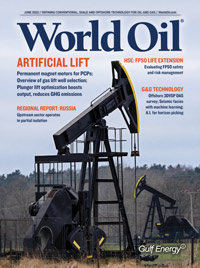Issue: June 2022
Features
Recent moves by the UK government of Prime Minister Boris Johnson indicate that people in his regime must think that they can play both sides of the street, so to speak, when it comes to oil and gas policy, and get away with it. We are here to tell them that this is not practical, much less ethical and effective.
Fully automated seismic horizon picking dramatically shortens times between acquiring seismic data and defining drilling targets. Operators spend millions of man-hours interpreting seismic data to produce viable prospects. Freeing up time to better incorporate G&G properties within mapped structures enhances probabilities of discovering commercial pay.
For many companies, the biggest hurdle is not knowing how to accurately report on ESG goals to investors, in a way that directly correlates to their ROI. This article details the top four ways oil and gas companies can report ESG goals to investors.
DAS fiber deployed on several wells’ completion strings offshore recorded a 3DVSP survey with ongoing production, but with significant noise encountered. A novel, two-step approach on one well addressed fiber directivity response on recorded data to recover relative amplitudes. The final 3D VSP image showed improved spatial resolution over target intervals.
The invasion of Ukraine in February has burdened Russia’s exploration and production industry with a second round of constraints that have deep and far-ranging consequences.
An innovative production software platform enables automated allocation processes and provides high-accuracy data, significantly reducing time previously spent on manual tasks.
Insufficient permitting and leasing, coupled with flawed regulations, are hampering development and production of good offshore assets.
As the world’s FPSO fleet ages, 55 vessels are reaching the end of their design lives, and five more have life extension in place. With 19 more FPSOs being evaluated for life extension, a group of major players is evaluating possible safety issues from corrosion and other structural integrity concerns.
In an exclusive interview, Energy NL’s Charlene Johnson talks about the fortunate turn of events that has transformed the outlook for East Canada’s offshore activity.
With increasing volumes of produced water from existing deepwater Nigerian assets, it’s imperative to limit or prevent emulsifications. To solve the problem, a customized water clarifier was developed to ensure regulatory compliance to discharge requirements and optimize waste management practices.
Seismic data can provide useful information for prospect identification and reservoir characterization. Combining seismic attributes helps identify different patterns, thus improving geological characterization. Machine learning applied to seismic interpretation is very useful in assisting with data classification limitations.
Special Focus: Artificial Lift
Permanent magnet motors deliver higher efficiency and value for PCPs and optimized surface-drive technology.
This article reviews gas lift well selection and its inflow relationship with the reservoir; wellbore and facility parameters that must be addressed; unloading control (kill) fluid that is in the wellbore following all interventions to install downhole equipment; the optimization procedure; and more.
Marcellus shale gas wells are often challenged by increasing liquid loading frequency, yielding decreased production, reduced workforce efficiency, and increased GHG emissions, due to required well interventions. Leveraging data-driven, cloud-based plunger lift optimization, CNX Resources increased gas production and reduced GHG emissions.
Columns
In December 2021, China and Indonesia had a standoff over E&P in the southern South China Sea that involved unequivocal politico-military intimidation. While China has done this to the Philippines, Vietnam, and Japan, this was a first for Indonesia.
While the upstream market looks its best in three years, governmental interference continues to cause headaches. Herewith, we offer two examples from opposite sides of “the pond”—the U.S. and the UK.
To borrow a phrase from the recent Energy Workforce & Technology Council annual meeting, I believe the changes we’re seeing are an energy “expansion,” not an energy “transition.”
Early oil and gas developers considered the Permian basin a graveyard. However, this changed in 1923, and set off a series of major oil and gas discoveries that ultimately led to the development of greater Permian basin.
The next phase of oilfield water management will be desalination and discharge for uses outside of the oil field.
Why would I think the optics of pipelines are worth writing about? Perhaps it’s because pipelines are arguably the safest means of transporting hydrocarbon fluids, yet their reputation is undeservedly poor.
Resources
Crude prices climbed in May, as the war in Ukraine persisted. Experts predicted a drawn-out battle, which exacerbated concerns over the loss of Russian supplies, even after the war ends.



